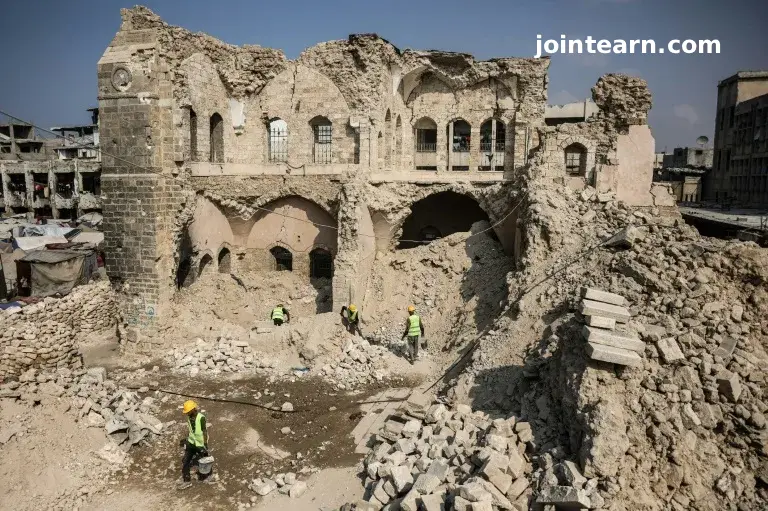
Gaza City, November 13, 2025 — In the heart of Gaza City, teams of Palestinian heritage workers have begun the painstaking task of restoring the Pasha’s Palace Museum, a centuries-old fortress and one of Gaza’s most significant historical landmarks, after it sustained severe damage during two years of war between Israel and Hamas.
The project marks a symbolic step toward reclaiming Gaza’s cultural identity after widespread destruction to historical and archaeological sites across the territory.
Rebuilding Gaza’s Heritage, Stone by Stone
Wearing high-visibility vests and armed with little more than shovels, buckets, and brushes, workers meticulously clear debris from the remains of the medieval fort. The Pasha’s Palace, which local legend says hosted Napoleon Bonaparte during his brief campaign in Gaza, once housed over 40,000 archaeological artifacts representing a succession of civilizations — from the Canaanites and Byzantines to the Ottoman Empire.
Now, under the constant buzz of Israeli surveillance drones, the workers labor quietly, salvaging stone fragments for reuse in the palace’s eventual reconstruction.
“The Pasha Palace Museum is one of the most important sites destroyed during the recent war on Gaza City,” said Hamouda al-Dahdar, the cultural heritage expert overseeing the restoration. “More than 70 percent of the palace’s buildings were destroyed.”
UNESCO and Local Efforts to Save Gaza’s Heritage
According to UNESCO, by October 2025, at least 114 cultural heritage sites across Gaza had been damaged since the conflict began on October 7, 2023. These include the Saint Hilarion Monastery, one of the oldest Christian monasteries in the Middle East, and Gaza City’s Great Omari Mosque, a historic structure with origins in the 7th century.
Cultural heritage expert Issam Juha, who heads the Centre for Cultural Heritage Preservation in the West Bank, is helping coordinate restoration efforts remotely. He told AFP that the biggest challenge facing Gaza’s cultural recovery is the severe shortage of materials due to Israel’s blockade.
“There are no more materials. We’re only managing debris, collecting and sorting stones, and carrying out minimal consolidation,” Juha said.
Israel’s strict restrictions on goods entering Gaza have hampered reconstruction across the enclave. Even after the US-brokered ceasefire in October 2025 allowed limited aid shipments, every truckload of materials must undergo Israeli vetting, slowing progress dramatically.
Recovering Gaza’s “Memory and Identity”
For Dahdar and his team, the work is about more than bricks and mortar. It’s a mission to preserve the identity and memory of the Palestinian people.
“Our cultural heritage is the identity and memory of the Palestinian people,” Dahdar said. “Before the war, the Pasha’s Palace contained more than 17,000 artifacts, but unfortunately, all of them disappeared after the invasion of the Old City of Gaza.”
So far, Dahdar’s team has recovered about 20 significant artifacts, including relics from the Roman, Byzantine, and Islamic eras. Each discovery is carefully documented and preserved as part of the long-term restoration plan.
Heritage Lost and Found
The Pasha’s Palace Museum, also known as Qasr al-Basha, was not only a symbol of Gaza’s layered past but also a centerpiece of its tourism and educational landscape. Its loss has been deeply felt by residents who view the site as a tangible link to their ancestors.
“We are salvaging archaeological stones for future restoration work,” Dahdar explained, “and rescuing any artifacts that were on display inside the museum.”
As workers cleared rubble several meters high, one craftsman carefully restored a stone carving bearing a cross intertwined with an Islamic crescent, symbolizing centuries of coexistence. Another delicately brushed dust from a fragment inscribed with Arabic calligraphy.
The Broader Cultural Toll of War
Juha’s organization estimates that at least 226 cultural and heritage sites across Gaza have been damaged or destroyed — nearly double UNESCO’s figure — due to on-the-ground assessments by local teams.
These include archaeological ruins, ancient mosques, churches, and museums. Many heritage advocates fear that without international intervention and sustained funding, much of Gaza’s historical legacy could be lost forever.
“We are not dealing with just an old building,” Dahdar said. “We are working with monuments that date back to many different eras — each one a chapter in the story of Gaza.”
Despite the immense challenges, Gaza’s archaeologists and craftsmen remain determined. For them, restoring the Pasha’s Palace Museum is not only an act of reconstruction but also one of cultural resistance — preserving the history of a people who refuse to be erased.


Leave a Reply